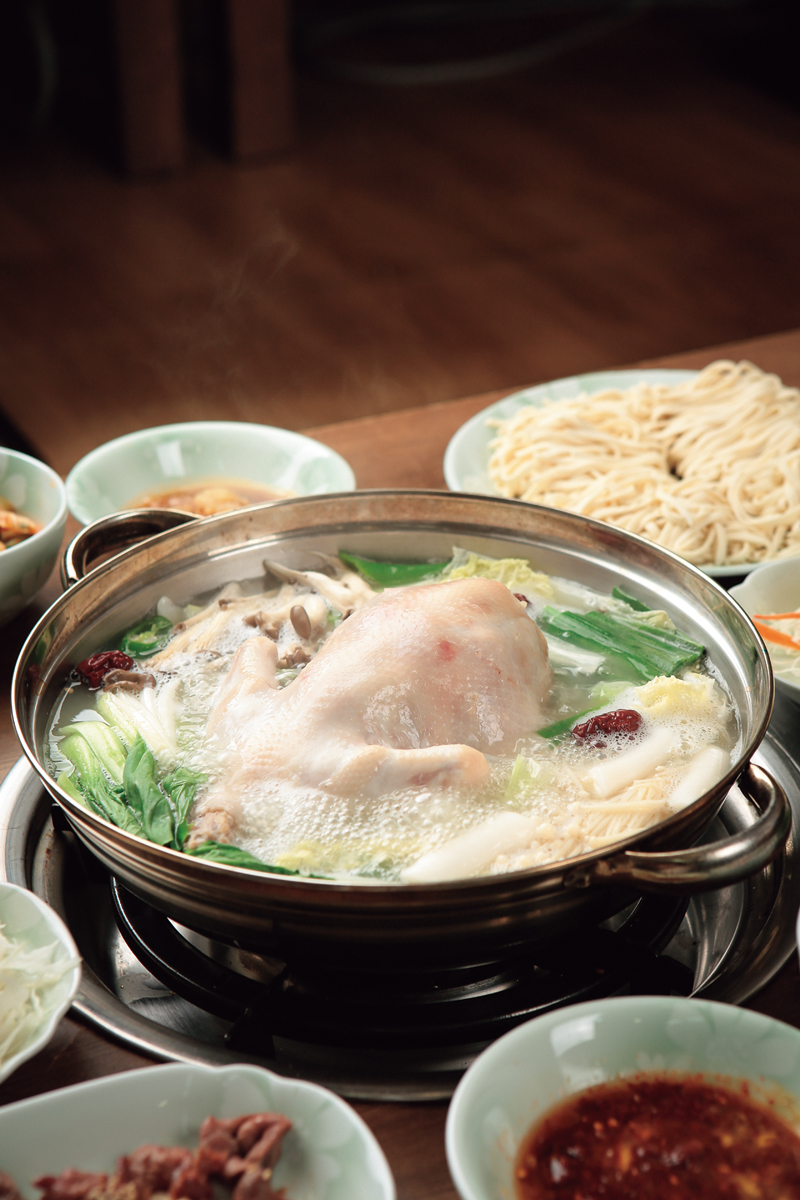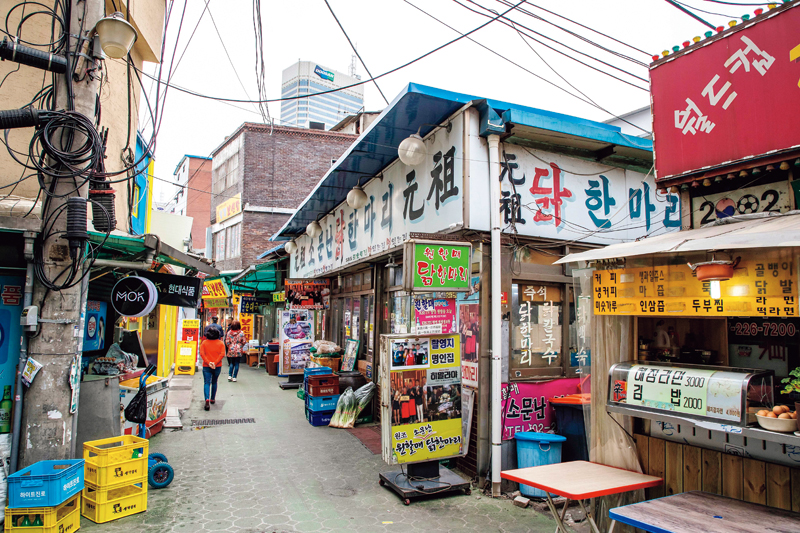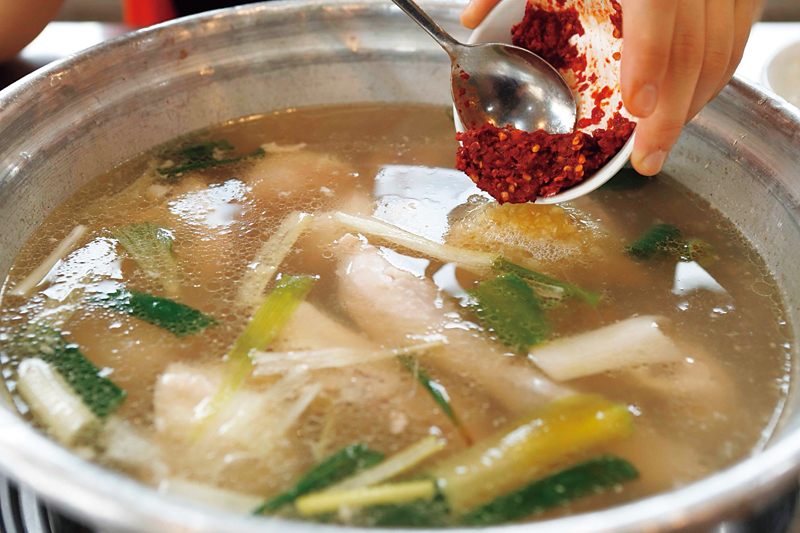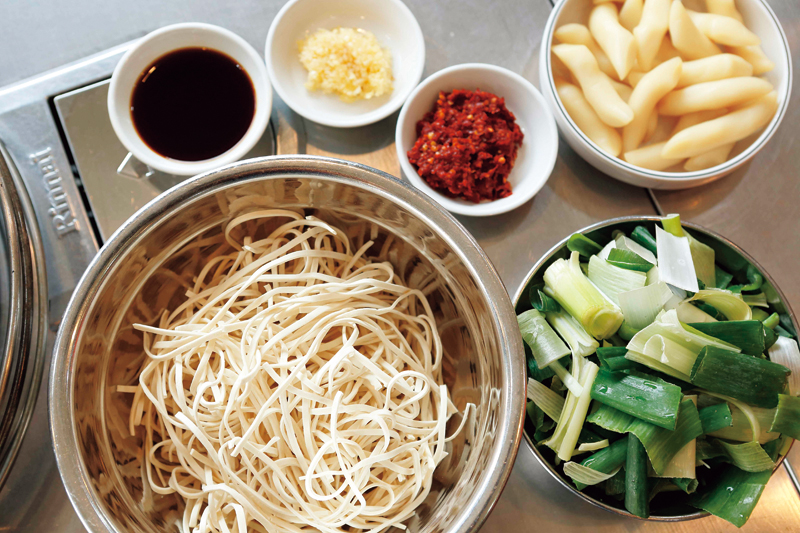Dakhanmari is a soup dish that originated in Seoul and is believed to date back to the 1960s. Served in a large metal pot and containing an entire chicken, this unassuming dish not only tastes good, it also offers a glimpse into the era of Seoul’s rapid growth and the lives of its hard-working citizens.

Dakhanmari, a classic dish that originated in Seoul, is prepared by boiling a whole chicken with different ingredients inside a large pot. You enjoy it by dipping small pieces of chicken and other ingredients into a custom-made sauce.
© Getty Images Korea
The names of Korean dishes, such as kimchi jjigae (kimchi stew), japchae (stir-fried glass noodles), or tteokbokki (stir-fried rice cakes), typically include the main ingredient as well as the respective cooking or seasoning methods. In contrast, dakhanmari has a straightforward name that recalls basic arithmetic — it literally means “one whole chicken.” But if a customer were to ask for three chickens, they would need to ask for “three one-whole chickens” to avoid causing confusion.
THE STORY BEHIND DAKHANMARI
The dish’s name doesn’t offer much insight into its origins, although this hasn’t stopped food experts from speculating. When dakhanmari first emerged, chicken was still considered something of a luxury. Although it remains highly sought after today, dakhanmari was much more expensive back then. The idea of eating an entire chicken in one sitting was almost unthinkable, so the dish was considered a special treat. That’s why it holds a cherished place in the hearts of many Koreans, like the Thanksgiving turkey does for Americans.
Dakhanmari’s rise in popularity coincided with the rapid expansion of Korea’s poultry industry and the advent of industrial-scale chicken production. As a result, restaurants were now able to serve up a dish containing one whole chicken at a lower price. Korean culture has a tradition of placing special significance on foods served whole or used in ancestral rites, which likely contributed to dakhanmari’s popularity.
Even today, many Koreans still refer to fried chicken as tongdak, or “whole chicken,” regardless of whether it is actually fried in one piece or many pieces. The term “tong” implies completeness, abundance, and perfection. The name “dakhanmari” also reflects this idea, signifying not just double the amount of dakbanmari, half a chicken, but a truly complete dish.
FLAVOR STEEPED IN HISTORY
Amid the clothing store-lined alleys of Dongdaemun in central Seoul, there is one dedicated entirely to restaurants serving dakhanmari, some of which have been operating for over thirty years. To fully appreciate the area, it is helpful to understand its history. Originally, the alley was part of a market. When Yi Seong-gye, the founder of the Joseon Dynasty, moved the kingdom’s capital to Seoul in the late 14th century, a government-regulated market formed in front of Gwanghwamun, the entrance to Gyeongbok Palace. It extended down to today’s Jongno, the main thoroughfare running through the eponymous district. The area around the famous Dakhanmari Alley grew into a bustling neighborhood inhabited by commoners, and another market sprung up there too. Following the Korean War, a surge in population led to the expansion of urban markets, including Dongdaemun Market, Gwangjang Market, and Pyeonghwa Market, which played a key role in popularizing the dish.
The markets were both shopping hubs and places of work for many Koreans, including those involved in manufacturing clothes in the Dongdaemun area. After a long day, workers would seek a place to enjoy a meal and unwind with drinks. Dakhanmari quickly became popular because it offered generous portions of meat and a fantastic flavor.

Once a gathering spot for nearby market vendors and office workers, Dongdaemun’s Dakhanmari Alley now draws international visitors eager to try out this lesser-known Korean dish.
© KOREA TOURISM ORGANIZATION
Two main theories exist regarding the origins of the dish. One suggests that dakhanmari was first served at restaurants specializing in dakbaeksuk, a similar type of chicken soup. These establishments apparently began adding kalguksu (handmade, knife-cut noodles), tteok (rice cakes), and vegetables to the dish in order to create a complete, one-pot meal. The other theory suggests that dakhanmari originated in chicken kalguksu restaurants, where dakbaeksuk was offered as a side for drinks in the evening. Over time, these establishments would have added their own special seasoning to the soup, giving rise to the dish known today as dakhanmari.
Throughout the 1970s and 1980s, Seoul saw a rapid increase not only in market vendors but also in white-collar workers. After a demanding day, such workers would often gather to relax over drinks until late in the evening. Exploring Seoul’s best eateries became sort of a trend, as many sought more than just affordable and tasty food. In this context, dakhanmari offered a new and unique experience.
Unlike dakbaeksuk or samgyetang (ginseng chicken soup), which are served in individual portions, dakhanmari is usually presented in a battered metal pot containing a whole chicken intended for sharing. Enjoyed with a dipping sauce that can be customized to suit individual tastes, the dish goes perfectly with a glass of soju. As it gained popularity, more and more people began flocking to the Dakhanmari Alley, and astute vendors specializing in the dish began opening up restaurants in other parts of Seoul.
Today, a surprising number of Koreans remain unfamiliar with this dish because it is rarely cooked at home. This is especially true for children and young students, as well as those who rarely dine out. Traditionally, dakhanmari wasn’t regarded as a home recipe, and the pot used to serve it is not commonly found in most households. Moreover, since its flavor is largely determined by the broth and dipping sauce, it has come to be regarded as a specialty best enjoyed at well-established restaurants. Sitting at a table with a built-in hot plate and eating the dish while it boils away also adds to the appeal. What should also not be forgotten are the dish’s working-class roots and why it became popular in the first place.
HAPPINESS IN A POT
To make dakhanmari, a whole chicken is added to a large metal pot filled with vegetables and a special broth made in accordance with each establishment’s secret recipe. The basin-like pot, called yangpun was traditionally made of thin bronze but is now commonly made of aluminum or stainless steel. Although the chicken is served already cooked, other ingredients like tteok, green onions, potatoes, and mushrooms must be left to simmer until tender. While all the flavors come together, diners can create their own dipping sauces by mixing ingredients such as soy sauce, vinegar, mustard, and dadaegi (a spicy condiment made from minced chili peppers, garlic and other ingredients). Even with the same ingredients, the flavor of each sauce can differ significantly based on the combinations and quantities used. Once the contents of the soup have been consumed, noodles can be added to the pot. Any remaining sauce can be used to dip in the noodles, or it can be mixed into the broth with some kimchi to create a spicy noodle soup.


When all the chicken has been eaten, noodles and extra seasoning can be added to the remaining broth to create a spicy noodle soup.
© KOREA TOURISM ORGANIZATION
Eating dakhanmari together fosters a sense of companionship among those sitting around the table, and the minimal involvement of restaurant staff in the dish’s preparation helps keep costs down. This setup creates a win-win situation for both customers and restaurant owners, which reflects the Korean saying “what’s good for one’s sister is also good for her husband.” Dakhanmari is unlikely to be offered at a five-star hotel or Michelin-starred restaurant, and no one would suggest taking an important client out to a meal of dakhanmari when looking to close a major deal. That’s because people believe it is best enjoyed in a more casual and intimate setting.
Recently, dakhanmari has emerged as a popular food among foreign visitors to Korea. Although part of its appeal comes from allowing you to enjoy an authentic yet non-spicy Korean dining experience, the dish also gives people the chance to reflect on Seoul’s tumultuous past, offering a glimpse into the city’s era of rapid growth and a taste of what fueled its hard-working population during that time.
A favorite among locals and tourists alike, dakhanmari has now become part of Seoul’s sociocultural heritage. Almost every Korean dish comes with its own story, often a blend of both painful and joyful memories. Understanding the historical context can only enrich the appreciation of the food you are eating. Cuisine is about much more than just calories, chemical composition, or texture, and dakhanmari is a prime example of this. It is difficult to imagine enjoying this dish alone — dakhanmari’s true appeal lies in its power to gather friends and family around a large, bubbling pot to enjoy a tasty meal in each other’s company.